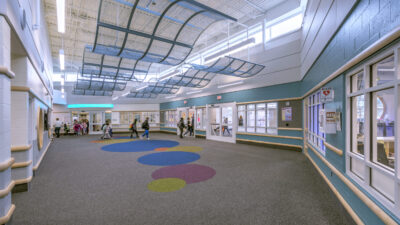Traditionally, classrooms have been approached as spaces where acoustical needs could easily be met with a lay-in, sound-absorbing ceiling. But more is often necessary. Fortunately, the American National Standards Institute's Acoustical Performance Criteria, Design Requirements, and Guidelines for Schools (ANSI S12.
Traditionally, classrooms have been approached as spaces where acoustical needs could easily be met with a lay-in, sound-absorbing ceiling. But more is often necessary.
Fortunately, the American National Standards Institute’s Acoustical Performance Criteria, Design Requirements, and Guidelines for Schools (ANSI S12.60), has expanded the palette considerably, addressing a much-overlooked aspect of facility design.
Basically, the standard establishes criteria for:
Background noise levels, stipulated as maximum one-hour-average, A-weighted steady noise level.
Reverberation time, stipulated as decay of an interrupted sound of 60 dB noted at mid-frequencies of 500, 1,000 and 2,000 Hz.
Sound-isolating ability of demising assemblies including walls, floor-ceilings and roof-ceilings, stipulated as sound transmission class (STC) ratings with suggested field-verified noise isolation class (NIC) ratings.
The standard covers a range of classroom types, but for an average classroom within the range of 10,000—20,000 cu. ft., background noise levels are limited to 35 dBA. Reverberation time should not exceed 0.7 secs. Perimeter construction should possess an STC rating of 50 or higher.
In our experience, while most classrooms in this size range adhere to the reverberation and sound isolation criteria, these spaces exceed the background noise criteria. In some classrooms, noise levels have been high enough to cause complaints from teachers and students. On the other hand, noise levels in other classrooms, while exceeding the letter of ANSI S12.60, elicited no complaints.
This observation, while limited to the range of our experience, may partially explain the reticence of school boards to require compliance. If they adopt S12.60 as a requirement for the facilities they administrate, school leaders may fear they are “lead-ballooning” many school projects and eliminating other new projects.
To date, none of the school districts we have been involved with have directed designers to adhere to S12.60. Many school officials inquire as to the applicability of the standard, but few are interested in testing to gauge whether they would be in compliance.
In reality, the typical classroom is equipped with fluorescent lighting and variable-air-volume HVAC systems that produce noise readily exceeding the criteria stipulated in ANSI S12.60. When each lighting fixture, air diffuser and return air grille is producing noise at the level of design intent, the total level generated in the room will actually be several decibels—theoretically, as many as 10 dB, but usually 4—6 dB—higher due to the principle of combining sound levels. Designers must make significant reductions in sound levels generated by these components if S12.60 is stipulated.
Another difficulty in applying the background noise requirements of this standard occurs when schools are constructed within five miles of a major international airport or approximately 100 ft. from major vehicle thoroughfares or railroad tracks. The standard allows an increase in the background noise limit to 40 dBA for a typical classroom in such cases, provided the “noisiest hour” has no more than six minutes of noise levels exceeding this value. Many classrooms facing these noise sources would fail the standard. And unfortunately, most remedial measures to adhere to the standard would be extensive.
While ANSI S12.60 addresses a long overlooked, yet important area of acoustics and offers excellent guidelines for employing design techniques aimed at improving speech intelligibility in classrooms, the standard has its impractical aspects, which, thus far, appear to limit its universal acceptance.



